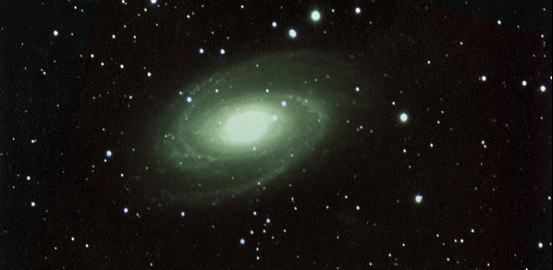


M81 is a beautiful rotating disk of about 250 Billion stars located near the big dipper, at an estimated distance of 12 million light years. The haze that seems to make up the galaxy is in reality billions and billions of individual stars. Some of the brighter star-like objects may be globular clusters, which are dense clumps of tens of thousands of stars, others are likely foreground stars in our own galaxy. Also note the two faint spiral arms extending out of the disk of the galaxy.
This is basically the m81 image I took last month, but I went out and got some additional frames through Red, Green and Blue filters, so I was able to build a color image, using the new “color” frames plus the original image (the original B&W image was used to supply the brightness or “luminance” data for the picture—this is referred to as LRGB imaging). This is one of the first images I have taken with my Starlight Express MX716, which is significantly less noisy then my older ATiK 2HS (specifically because of its Active Cooling system which freezes the imaging chip down to about 30 degrees Celsius below the ambient temperature—heat noise from Infrared photons emanating from warm surfaces with the camera itself were a significant problem when doing long exposures with the older camera). The image stacks taken through the red, green and blue filters (about 25 1 minute exposures each) were separately Stacked and Aligned using k3ccd, and then the separate completed Red, Green, Blue and White-Light images were finally aligned and combined using RegiStar (a very powerful program for image alignment, but also fairly expensive given that it doesn’t do anything else). Final color tweaking (etc.) was done in JASC Paint Shop. It is extremely difficult to know how accurate the color really is, I just tweaked it in PaintShop until most of the stars turned white. Other software used includes AstroArt (which I use for camera control and initial image processing), and PixInsight, a *Free* Astro-Imaging program with some very powerful features for removing light pollution gradients (an increasing problem out here).
As usual, image was taken from my backyard near Howell, Michigan. Lessons learned include not allowing the dog to dig under the tripod legs while imaging.
Final Statistics:
110 * 60 seconds white light (“Luminance”);
25 * 60 seconds each through R, G and B filters;
Total Sleep: about 5 hours
Televue Genesis 4” F5 Refractor with Starlight Express MX716 Camera, image is just under 1” across (main diagonal).